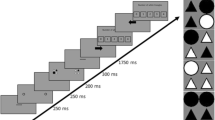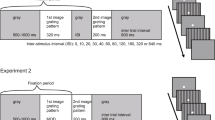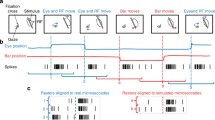Abstract
• Background: Recent studies have shown that transient constrictions of the pupil can be elicited by visual stimuli that do not cause an increment in light flux level on the retina. Such stimuli include achromatic gratings and isoluminant chromatic patterns. • Method: We investigated pupillary responses to the onset of coherent movement generated in a pattern of dots in random motion. Measurements were carried out in normal observers and in a subject with hemianopia caused by damaged primary visual cortex. • Results: The experimental findings show that the onset of coherent motion triggers systematic constrictions of the pupil that cannot be accounted for in terms of a pupil light reflex response. We labelled these constrictions Pupil motion responses (PMRs). Results show that PMRs have large response latencies and on average are of small response amplitudes. The dependence of PMRs on changes in motion parameters such as stimulus speed and direction of motion has been investigated. • Conclusions: The existence of PMRs to the onset of the coherent motion in human vision has been demonstrated. These new findings are discussed in relation to the psychophysical and physiological data on motion perception and the possible pathways involved in the control of the pupil response.
Similar content being viewed by others
References
Adelson EH, Bergen JR (1985) Spatiotemporal energy models for the perception of motion. J Opt Soc Am A 2: 284–299
Albright TD (1984) Direction and orientation selectivity of neurones in visual area MT of the macaque. J Neurophysiol 52: 1106–1130
Barbur JL (1985) Speed discrimination and its relation to involuntary eye-movements in human vision. Neurosci Lett 54: 7–12
Barbur JL (1992) The P-SCAN 100 system for simultaneous measurements of pupil size and eye movement. J Psychophysiol 5: 231–239
Barbur JL (1995) A study of pupil response components in human vision. In: Robbins JG, Djamgoz MBA, Taylor A (eds) Basic and clinical perspectives in vision research. Plenum, New York, pp 3–18
Barbur JL, Sahraie A (1995) Motion detection of single targets: spatial and temporal requirements. Perception 24: 106–107
Barbur JL, Thomson WD (1987) Pupil response as an objective measure of visual acuity. Ophthalmic Physiol Opt 7: 425–429
Barbur JL, Ruddock KH, Waterfield VA (1980) Human visual responses in the absence of the geniculo-calcarine projection. Brain 103: 905–928
Barbur JL, Keenleyside MS, Thomson WD (1987a) Investigation of central visual processing by means of pupillometry. In: Kulikowski JJ, Murray IJ, Dickinson CM (eds) Seeing Contour and Colour: Proceedings of 3rd International Symposium of Northern Eye Institute, Manchester, UK. Pergamon Press, Oxford
Barbur JL, Thomson WD, Forsyth PM (1987b) A new system for the simultaneous measurement of pupil size and two-dimensional eye movements. Clin Vision Sci 2: 131–142
Barbur JL, Harlow AJ, Sahraie A (1992) Papillary responses to structure, colour and movement. Ophthalmic Physiol Opt 12: 137–141
Barbur JL, Birch J, Harlow AJ (1993a) Colour vision testing using spatiotemporal luminance masking (Psychophysical and pupillometric methods). In: Drum B (ed) Colour Vision Deficiencies XI: 417–426. Kluwer Academic Publishers, The Netherlands
Barbur JL, Watson DG, Frackowiak RSJ, Zeki S (1993b) Conscious visual perception without V1. Brain 116: 1293–1302
Barbur JL, Harlow AJ, Weiskrantz L (1994) Spatial and temporal response properties of residual vision in a case of hemianopia. Philos Trans R Soc Lond B 343: 157–166
Barford NC (1967) Experimental measurements, precision, error and truth. Addison-Wesley, Reading, Mass
Blythe IM, Kennard C, Ruddock KH (1987) Residual vision in patients with retrogeniculate lesions of the visual pathways. Brain 110: 887–905
Cocker KD, Moseley MJ (1992) Visual acuity and the pupil grating response. Clin Vision Sci 7: 143–146
Cocker KD, Moseley MJ, Bissenden JG, Fielder AR (1994) Visual acuity and pupillary responses to spatial structure in infants. Invest Ophthalmol Vis Sci 35: 2620–2625
De Valois RL, Yund EW, Hepler N (1982) The orientation and direction selectivity of cells in macaque visual cortex. Vision Res 22: 531–544
DeYoe EA, van Essen DC (1985) Segregation of efferent connections and receptive field properties in visual area V2 of the macaque. Nature 317: 58–61
Felleman DJ, van Essen DC (1987) Receptive field properties of neurones in area V3 of macaque extrastriate cortex. J Neurosci 4: 889–920
Hubel DH, Wiesel TN (1962) Receptive fields, binocular interactions and functional architecture in the cat's visual cortex. J Physiol 160: 106–154
Jones EG, Powel TPS (1970) An anatomical study of converging sensory pathways within the central cortex of the monkey. Brain 93: 793–802
Keenleyside MS (1989) Pupillometry and assessment of visual function. D.Phil. thesis, University of Oxford
Keenleyside MS, Barbur JL, Pinney HD (1988) Stimulus-specific papillary responses in normal and hemianopic subjects. Perception 17: 347
Kohn M, Clynes M (1969) Colour dynamics of the pupil. Ann NY Acad Sci 156: 931–950
Levinson E, Sekuler R (1976) Adaptation alters perceived direction of motion. Vision Res 16: 779–781
Livingstone MS, Hubel DH (1984) Anatomy and physiology of colour system in the primate visual cortex. J Neurosci 4: 309–356
Maunsell JHR, van Essen DC (1983) Functional properties of neurones in middle temporal visual area of the macaque monkey. I. Selectivity for stimulus direction, speed and orientation. J Neurophysiol 49: 1127–1147
Maunsell JHR, Newsome WT (1987) Visual processing in monkey extrastriate cortex. Annu Rev Neurosci 10: 363–401
Mikami A (1991) Direction selective neurones respond to short-range and long-range apparent motion stimuli. Int J Neurosci 61: 101–112
Mikami A, Newsome WT, Wurtz RH (1986) Motion selectivity in macaque visual cortex. I. Mechanisms of direction and speed selectivity in extrastriate area MT. J Neurophysiol 55: 1308–1327
Movshon JA, Adelson EH, Gizzi MS, Newsome WT (1985) The analysis of moving visual patterns. In: Chagas C, Gattass R, Gross CG (eds) Pattern recognition mechanisms. Springer, Berlin Heidelberg New York
Orban GA, Kennedy H, Maes H (1981) Response to movement of neurones in area 17 & 18 of the cat: velocity sensitivity. J Neurophysiol 45: 1043–1048
Orban GA, Kennedy H, Bullier J (1986) Velocity sensitivity and direction selectivity of neurones in areas V1 and V2 of the monkey: influence of eccentricity. J Neurophysiol 56: 462–480
Poggio GF, Doty RW, Talbot WH (1977) Foveal striate cortex of behaving monkey: single-neurone responses to squarewave gratings during fixation gaze. J Neurophysiol 40: 1369–1391
Sahraie A (1993) Some aspects of the pupil response in relation to stimulus movement and colour. PhD thesis, City University, London
Slooter JH (1985) The pupil, mirror of visual acuity. PhD monograph, Catholic University of Nijmegen, The Netherlands
Slooter JH, van Norren D (1980) Visual acuity measured with pupil responses to checkerboard stimuli. Invest Ophthalmol Vis Sci 19: 105–108
Stoerig P, Cowey A (1991) Incrementthreshold spectral sensitivity in blind-sight. Evidence for colour-opponency. Brain 114: 1487–1512
Tanaka K, Hikosaka K, Saito H, Yukie M, Fukada Y, Iwai E (1986) Analysis of local and wide-field movements in the superior temporal visual areas of the macaque monkey. J Neurosci 6: 134–144
Ukai K (1995) Spatial pattern as a stimulus to the pupillary system. J Opt Soc Am A 2: 1094–1100
van Essen DC (1985) Functional organization of primate visual cortex. In: Peters A, Jones EG (eds) Cerebral cortex. Plenum, New York
Varjú D (1964) Der Einfluß sinusförmiger Leuchtdichteänderungen auf die mittlere Pupillenweite und auf die subjektive Helligkeit. Kybernetik 2: 33–43
Weiskrantz L, Harlow A, Barbur JL (1991) Factors affecting visual sensitivity in a hemianopic subjects. Brain 114: 2269–2282
Weiskrantz L, Barbur JL, Sahraie A (1995) Parameters affecting conscious versus unconscious visual discrimination without V1. Proc Nal Acad Sci USA, 92: 6122–6126
Young RSL, Alpern M (1980) Pupil responses to foveal exchanges of monochromatic lights. J Opt Soc Am 70: 697–706
Zeki SM (1980) The response properties of cells in the middle temporal area (area MT) of owl monkey visual cortex. Proc R Soc Lond B 207: 239–248
Author information
Authors and Affiliations
Corresponding author
Rights and permissions
About this article
Cite this article
Sahraie, A., Barbur, J.L. Pupil response triggered by the onset of coherent motion. Graefe's Arch Clin Exp Ophthalmol 235, 494–500 (1997). https://doi.org/10.1007/BF00947006
Received:
Revised:
Accepted:
Issue Date:
DOI: https://doi.org/10.1007/BF00947006




